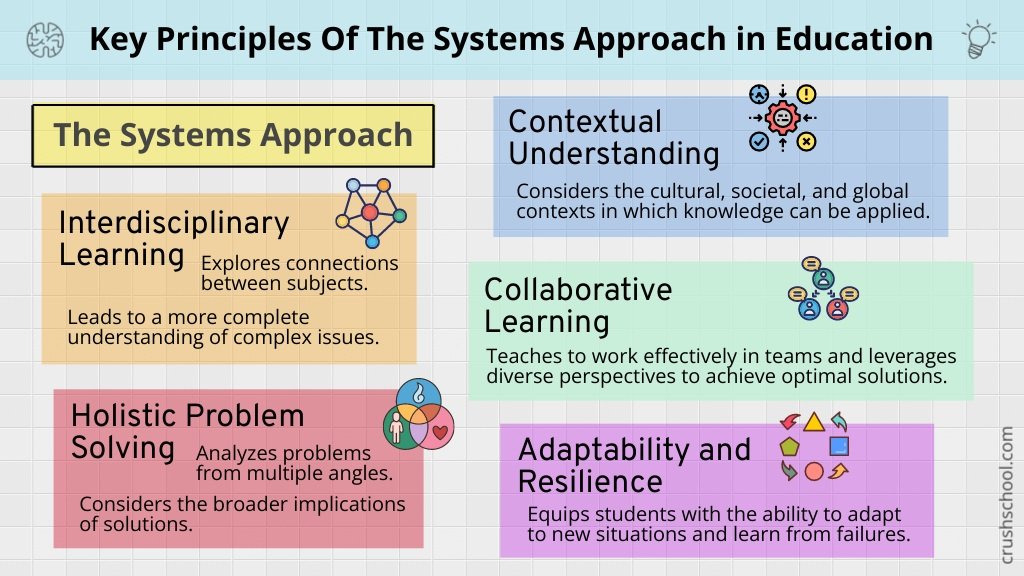The Systems Approach in Education: Nurturing Holistic Learning
In a world of rapid change and increasing complexity, traditional education often falls short in adequately preparing students for the challenges we are currently facing. Population growth, resource demands and exploitation, climate change, disease, sustainability, poverty, peace and security, human rights… are all interconnected. One affects another no matter how hard we try to separate them and deal with each issue one by one, and perhaps this is why it is time to give up the status quo way of educating in favor of the systems approach.
Understanding the Systems Approach
The systems approach finds any system as not just a collection of individual parts, but an integrated whole where the interactions between these parts create emergent behaviors (behaviors that emerge from the interactions of various parts of the system).
In traditional education, we often compartmentalize subjects and treat their topics in isolation. In contrast, the systems approach encourages an interdisciplinary perspective. It emphasizes the interconnectedness of subjects, encouraging students to understand how knowledge and skills from various domains can be used to solve real-world problems. This approach mirrors the complexity of real-life situations, where challenges rarely fit into a single academic field.
Key Principles of the Systems Approach in Education
Interdisciplinary Learning: The systems approach promotes learning that transcends disciplines. By encouraging students to explore connections between subjects, it equips them with a more comprehensive understanding of complex issues.
Holistic Problem Solving: In the real world, challenges are multifaceted. The systems approach teaches students to analyze problems from multiple angles and consider the broader implications of their solutions.
Contextual Understanding: Education should not occur in a vacuum. The systems approach encourages students to consider the cultural, societal, and global contexts in which their knowledge can be applied.
Adaptability and Resilience: Complex systems are adaptable and resilient. The systems approach equips students with the ability to adapt to new situations and learn from failures.
Collaborative Learning: Systems thinking involves understanding of relationships and interactions, which encourages collaborative learning. Students learn to work effectively in teams, leveraging diverse perspectives to achieve optimal solutions.
Effective Implementation of the Systems Approach
Curriculum Design: A systems-focused curriculum incorporates Phenomenon-Based Learning (PhenBL), which promotes case studies, real-world simulations, and interdisciplinary projects. Investigating multifaceted phenomena exposes students to the complex connections between topics associated with seemingly disparate subjects and how a more holistic understanding can be used to create more meaningful solutions.
Assessment Methods: Traditional exams cannot correctly evaluate systems thinking skills. Performance assessments, such as designing and performing investigations, creating multimedia products, and solving real-world problems can better measure a student's ability to connect various subjects and issues.
Teacher Training: Teachers are key to promoting the systems approach. Adequate PD should focus on enhancing teachers' ability to design more holistic lesson plans, facilitate collaborative learning, and guide students in applying systems thinking.
Technology: Technology can facilitate the systems approach by providing tools for visualizing and simulating complex systems and connecting with experts from various fields, transcending geographical limitations.
Benefits of The Systems Approach
Embracing the systems approach in education offers numerous benefits. Students develop critical thinking skills, a deeper understanding of real-world complexity, and an enhanced ability to innovate. By fostering collaboration and adaptability, this approach prepares students for careers in a rapidly changing job market.
Future Implications of The Systems Approach
However, transitioning to a systems approach requires a paradigm shift in education. Curricula need to be replaced by approaches such as Phenomenon- or Project-Based Learning. The evaluation metrics for student success need to evolve in kind to gauge the complex, multifaceted, and transferable skills developed through using the systems approach.
The systems approach aims to bridge the gap between the classroom and the real-world. By cultivating holistic thinking, interdisciplinary learning, collaboration, and learning from mistakes, the systems approach equips students with the skills necessary to navigate the complexities of the modern era. The world of education must continue to embrace and improve holistic learning models such as the systems approach to move the society closer to a future in which students learn how to solve (and solve) global challenges in the classroom.
If you found this post helpful, sign up for my Teaching Tips, Resources, & Ideas Newsletter to get the next article when it drops. It’s totally free.
BOOKS & TOOLS
- December 2025 1
- September 2025 2
- August 2025 5
- July 2025 4
- June 2025 2
- August 2024 2
- July 2024 2
- June 2024 1
- October 2023 1
- September 2023 3
- August 2023 6
- July 2023 6
- July 2022 2
- June 2022 1
- November 2020 3
- October 2020 3
- April 2020 1
- March 2020 5
- July 2019 1
- June 2019 1
- April 2019 1
- January 2019 1
- November 2018 3
- October 2018 2
- September 2018 1
- August 2018 8
- July 2018 11
- June 2018 4
- May 2018 5
- April 2018 2
- March 2018 4
- February 2018 5
- January 2018 3
- December 2017 1
- November 2017 5
- October 2017 7
- September 2017 6
- August 2017 5
- July 2017 3
- June 2017 10
- May 2017 7
- April 2017 7
- March 2017 15
- February 2017 12
- January 2017 13
- December 2016 15
- November 2016 8
- October 2016 7
- September 2016 12
- August 2016 14
- July 2016 10
- June 2016 13
- May 2016 10
- April 2016 8
- March 2016 5
- February 2016 7
- January 2016 6
- December 2015 5
- November 2015 8
- October 2015 2













